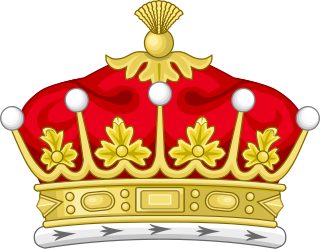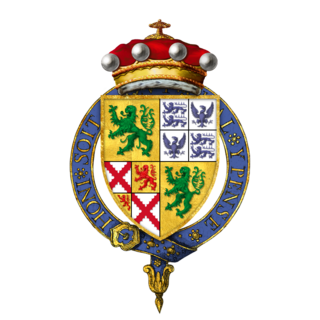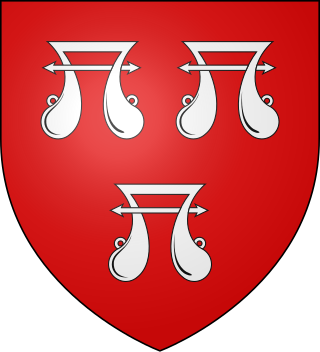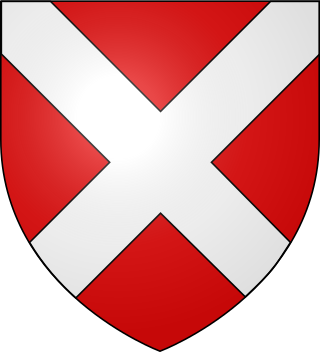
Earl of Worcester is a title that has been created five times in the Peerage of England. Worcester is a cathedral city in Worcestershire, England.

Earl of Worcester is a title that has been created five times in the Peerage of England. Worcester is a cathedral city in Worcestershire, England.
The first creation came in 1138 in favour of the Norman noble Waleran de Beaumont. He was the son of Robert de Beaumont, 1st Earl of Leicester, by Elizabeth of Vermandois, and the twin brother of Robert de Beaumont, 2nd Earl of Leicester. Like his father and brother he also held the title Count of Meulan in the French nobility. The earldom of Worcester apparently became extinct on his death in 1166.
The second creation came in 1397 in favour of the military commander and governor Thomas Percy. He was a younger son of Henry de Percy, 3rd Baron Percy, and Mary of Lancaster, and the brother of Henry Percy, 1st Earl of Northumberland. He fought in the Hundred Years' War for Richard II, against whom he later rebelled. After the Battle of Shrewsbury, he was beheaded for treason and his honours forfeit, although he was without issue anyway.
The third creation came in 1420 in favour of Richard Beauchamp, 2nd Baron Bergavenny. He was the son of William de Beauchamp, younger son of Thomas de Beauchamp, 11th Earl of Warwick and Katherine Mortimer. William de Beauchamp was summoned to Parliament as "Willilmo Beauchamp de Bergavenny" on 23 July 1392, by which he is held to have become Baron Bergavenny. The earldom of Worcester became extinct on the death of its first holder in 1422, while the barony was passed on to his daughter and only child, Elizabeth. See Baron Bergavenny for further history of this title.
The fourth creation came in 1449 in favour of John Tiptoft, 2nd Baron Tiptoft, a noted scholar and sometime favourite of Edward IV. After the Lancastrians were restored to power under Henry VI, Worcester was captured and beheaded, with his titles forfeited. However, they were restored the following year in favour of his second and only surviving son Edward. Edward died at an early age in 1486. On his death the earldom became extinct while the barony became either extinct or fell into abeyance between his aunts. The barony of Tiptoft had been created on 7 January 1426 when the first Earl's father, John Tiptoft, was summoned to Parliament. He had previously served as Speaker of the House of Commons and Lord High Treasurer.
The fifth creation came in 1514 in favour of Charles Somerset, the legitimised son of Henry Beaufort, 3rd Duke of Somerset. The fifth Earl was made Marquess of Worcester in 1643 and the third Marquess Duke of Beaufort in 1682. See the latter title for more information on this creation.
| Family tree of the Dukes of Beaufort, Earls of Leicester, and Earls of Lancaster and Dukes of Lancaster, Earls of Worcester and Marquesses of Worcester | |||||||||||||||||||||||||||||||||||||||||||||||||||||||||||||||||||||||||||||||||||||||||||||||||||||||||||||||||||||||||||||||||||||||||||||||||||||||||||||||||||||||||||||||||||||||||||||||||||||||||||||||||||||||||||||||||||||||||||||||||||||||||||||||||||||||||||||||||||||||||||||||||||||||||||||||||||||||||||||||||||||||||||||||||||||||||||||||||||||||||||||||||||||||||||||||||||||||||||||||||||||||||||||||||||||||||||||||||||||||||||||||||||||||||||||||||||||||||||||||||||||||||||||||||||||||||||||||||||||||||||||||||||||||||||||||||||||||||||||||||||||||||||||||||||||||||||||||||||||||||||||||||||||||||||||||||||||||||||||||||||||||||||||||||||||||||||||||||||||||||||||||||||||||||||||||||||||||||||||||||||||||||||||||||||||||||||||||||||||||||||||||||||||||||||||||||||||||||||||||||||||||||||||||||||||||||||||||||||||||||||||||||||||||||||||||||||||||||||||||||||||||||||||||||||||||||||||||||||||||||||||||||||||||||||||||||||||||||||||||||||||||||||||||||||||||||||||||||||||||
|---|---|---|---|---|---|---|---|---|---|---|---|---|---|---|---|---|---|---|---|---|---|---|---|---|---|---|---|---|---|---|---|---|---|---|---|---|---|---|---|---|---|---|---|---|---|---|---|---|---|---|---|---|---|---|---|---|---|---|---|---|---|---|---|---|---|---|---|---|---|---|---|---|---|---|---|---|---|---|---|---|---|---|---|---|---|---|---|---|---|---|---|---|---|---|---|---|---|---|---|---|---|---|---|---|---|---|---|---|---|---|---|---|---|---|---|---|---|---|---|---|---|---|---|---|---|---|---|---|---|---|---|---|---|---|---|---|---|---|---|---|---|---|---|---|---|---|---|---|---|---|---|---|---|---|---|---|---|---|---|---|---|---|---|---|---|---|---|---|---|---|---|---|---|---|---|---|---|---|---|---|---|---|---|---|---|---|---|---|---|---|---|---|---|---|---|---|---|---|---|---|---|---|---|---|---|---|---|---|---|---|---|---|---|---|---|---|---|---|---|---|---|---|---|---|---|---|---|---|---|---|---|---|---|---|---|---|---|---|---|---|---|---|---|---|---|---|---|---|---|---|---|---|---|---|---|---|---|---|---|---|---|---|---|---|---|---|---|---|---|---|---|---|---|---|---|---|---|---|---|---|---|---|---|---|---|---|---|---|---|---|---|---|---|---|---|---|---|---|---|---|---|---|---|---|---|---|---|---|---|---|---|---|---|---|---|---|---|---|---|---|---|---|---|---|---|---|---|---|---|---|---|---|---|---|---|---|---|---|---|---|---|---|---|---|---|---|---|---|---|---|---|---|---|---|---|---|---|---|---|---|---|---|---|---|---|---|---|---|---|---|---|---|---|---|---|---|---|---|---|---|---|---|---|---|---|---|---|---|---|---|---|---|---|---|---|---|---|---|---|---|---|---|---|---|---|---|---|---|---|---|---|---|---|---|---|---|---|---|---|---|---|---|---|---|---|---|---|---|---|---|---|---|---|---|---|---|---|---|---|---|---|---|---|---|---|---|---|---|---|---|---|---|---|---|---|---|---|---|---|---|---|---|---|---|---|---|---|---|---|---|---|---|---|---|---|---|---|---|---|---|---|---|---|---|---|---|---|---|---|---|---|---|---|---|---|---|---|---|---|---|---|---|---|---|---|---|---|---|---|---|---|---|---|---|---|---|---|---|---|---|---|---|---|---|---|---|---|---|---|---|---|---|---|---|---|---|---|---|---|---|---|---|---|---|---|---|---|---|---|---|---|---|---|---|---|---|---|---|---|---|---|---|---|---|---|---|---|---|---|---|---|---|---|---|---|---|---|---|---|---|---|---|---|---|---|---|---|---|---|---|---|---|---|---|---|---|---|---|---|---|---|---|---|---|---|---|---|---|---|---|---|---|---|---|---|---|---|---|---|---|---|---|---|---|---|---|---|---|---|---|---|---|---|---|---|---|---|---|---|---|---|---|---|---|---|---|---|---|---|---|---|---|---|---|---|---|---|---|---|---|---|---|---|---|---|---|---|---|---|---|---|---|---|---|---|---|---|---|---|---|---|---|---|---|---|---|---|---|---|---|---|---|---|---|---|---|---|---|---|---|---|---|---|---|---|---|---|---|---|---|---|---|---|---|---|---|---|---|---|---|---|---|---|---|---|---|---|---|---|---|---|---|---|---|---|---|---|---|---|---|---|---|---|---|---|---|---|---|---|---|---|---|---|---|---|---|---|---|---|---|---|---|---|---|---|---|---|---|---|---|---|---|---|---|---|---|---|---|---|---|---|---|---|---|---|---|---|---|---|---|---|---|---|---|---|---|---|---|---|---|---|---|---|---|---|---|---|---|---|---|---|---|---|---|---|---|---|---|---|---|---|---|---|---|---|---|---|---|---|---|---|---|---|---|---|---|---|---|---|---|---|---|---|---|---|---|---|---|---|---|---|---|---|---|---|---|---|---|---|---|---|---|---|---|---|---|---|---|---|---|---|---|---|---|---|---|---|---|---|---|---|---|---|---|---|---|---|---|---|---|---|---|---|---|---|---|---|---|---|---|---|---|---|---|---|---|---|---|---|---|---|---|---|---|---|---|---|---|---|---|---|---|---|---|---|---|---|---|---|---|---|---|---|---|---|---|---|---|---|---|---|---|---|---|---|---|---|---|---|---|---|---|---|---|---|---|---|---|---|---|---|---|---|---|---|---|---|---|---|---|---|---|---|---|---|---|---|---|---|---|---|---|---|---|---|---|---|---|---|---|---|---|---|---|---|---|---|---|---|
| |||||||||||||||||||||||||||||||||||||||||||||||||||||||||||||||||||||||||||||||||||||||||||||||||||||||||||||||||||||||||||||||||||||||||||||||||||||||||||||||||||||||||||||||||||||||||||||||||||||||||||||||||||||||||||||||||||||||||||||||||||||||||||||||||||||||||||||||||||||||||||||||||||||||||||||||||||||||||||||||||||||||||||||||||||||||||||||||||||||||||||||||||||||||||||||||||||||||||||||||||||||||||||||||||||||||||||||||||||||||||||||||||||||||||||||||||||||||||||||||||||||||||||||||||||||||||||||||||||||||||||||||||||||||||||||||||||||||||||||||||||||||||||||||||||||||||||||||||||||||||||||||||||||||||||||||||||||||||||||||||||||||||||||||||||||||||||||||||||||||||||||||||||||||||||||||||||||||||||||||||||||||||||||||||||||||||||||||||||||||||||||||||||||||||||||||||||||||||||||||||||||||||||||||||||||||||||||||||||||||||||||||||||||||||||||||||||||||||||||||||||||||||||||||||||||||||||||||||||||||||||||||||||||||||||||||||||||||||||||||||||||||||||||||||||||||||||||||||||||||

Duke of Somerset, from the county of Somerset, is a title that has been created five times in the peerage of England. It is particularly associated with two families: the Beauforts, who held the title from the creation of 1448, and the Seymours, from the creation of 1547, in whose name the title is still held. The present dukedom is unique, in that the first holder of the title created it for himself in his capacity of Lord Protector of the Kingdom of England, using a power granted in the will of his nephew King Edward VI.

Earl of Warwick is one of the most prestigious titles in the peerages of the United Kingdom. The title has been created four times in English history, and the name refers to Warwick Castle and the town of Warwick.

Baron Audley is a title in the Peerage of England first created in 1313, by writ to the Parliament of England, for Sir Nicholas Audley of Heighley Castle, a member of the Anglo-Norman Audley family of Staffordshire.

The Lord High Constable of England is the seventh of the Great Officers of State, ranking beneath the Lord Great Chamberlain and above the Earl Marshal. This office is now called out of abeyance only for coronations. The Lord High Constable was originally the commander of the royal armies and the Master of the Horse. He was also, in conjunction with the Earl Marshal, president of the court of chivalry or court of honour. In feudal times, martial law was administered in the court of the Lord High Constable.

Earl of Westmorland is a title that has been created twice in the Peerage of England. The title was first created in 1397 for Ralph Neville. It was forfeited in 1571 by Charles Neville, 6th Earl of Westmorland, for leading the Rising of the North. It was revived in 1624 in favour of Sir Francis Fane, whose mother, Mary Neville, was a descendant of a younger son of the first Earl. The first Earl of the first creation had already become Baron Neville de Raby, and that was a subsidiary title for his successors. The current Earl holds the subsidiary title Baron Burghersh (1624).

Earl of March is a title that has been created several times in the Peerage of Scotland and the Peerage of England. The title derived from the "marches" or borderlands between England and either Wales or Scotland, and it was held by several great feudal families which owned lands in those districts. Later, however, the title came to be granted as an honorary dignity, and ceased to carry any associated power in the marches.
Baron Herbert is a title in the Peerage of England. It was created by writ in 1461 for William Herbert, who was later made Earl of Pembroke. The second Earl of Pembroke surrendered his earldom in return for the earldom of Huntingdon, which became extinct on his death without male issue. The barony, however, passed to his daughter Elizabeth, who later married the first Earl of Worcester. At Elizabeth's death, the title passed to her son, who later inherited his father's earldom of Worcester. Later, the fifth Earl was made Marquess of Worcester, and the third Marquess became Duke of Beaufort. Thereafter, the barony and dukedom remained united until 1984 when, upon the death of the tenth Duke without issue, the barony fell into abeyance. Then, in 2002, Queen Elizabeth II terminated the abeyance of the barony of Herbert in favour of the last holder's great-nephew, David John Seyfried.

Baron Stafford, referring to the town of Stafford, is a title that has been created several times in the Peerage of England. In the 14th century, the barons of the first creation were made earls. Those of the fifth creation, in the 17th century, became first viscounts and then earls. Since 1913, the title has been held by the Fitzherbert family.

Baron le Despencer is a title that has been created several times by writ in the Peerage of England.

Edward Sutton, 2nd Baron Dudley, was an English nobleman elected as Knight of the Garter (KG) in the beginning of King Henry VIII's reign. He was chamberlain to Princess Mary from 1525 to 1528.

Thomas Ros or Roos, 9th Baron Ros of Helmsley was a follower of the House of Lancaster during the Wars of the Roses.
The title Baron Bergavenny was created several times in the Peerage of England and once in the Peerage of Great Britain, all but the first being baronies created by error. Abergavenny is a market town in South East Wales with a castle established by the Norman lord Hamelin de Balun c. 1087.

The titles Baron Montacute or Baron Montagu were created several times in the Peerage of England for members of the House of Montagu. The family name was Latinised to de Monte Acuto, meaning "from the sharp mountain"; the French form is an ancient spelling of mont aigu, with identical meaning.

The title Baron Grey of Powis (1482–1552) was created for the great-grandson of Joan Charleton, co-heiress and 6th Lady of Powis (Powys) and her husband, Sir John Grey, 1st Earl of Tankerville (1384–1421) after the death of Joan's father, Edward Charleton, 5th Baron Cherleton (1370–1421) left the title in abeyance.

William de Beauchamp, 1st Baron Bergavenny, KG was an English peer.
Joan de Beauchamp, Baroness Bergavenny was an English noblewoman, and the wife of William de Beauchamp, 1st Baron Bergavenny of the Welsh Marches.
Elizabeth Fitzalan, Countess of Arundel, Countess of Surrey, was a member of the Anglo-Norman Bohun family, which wielded much power in the Welsh Marches and the English government. She was the first wife of Richard FitzAlan, a powerful English nobleman and military commander in the reigns of Edward III and Richard II. She was the mother of seven of his children, and as the wife of one of the most powerful nobles in the realm, enjoyed much prestige and took precedence over most of the other peers' wives.

The Neville or Nevill family is a noble house of early medieval origin, which was a leading force in English politics in the later Middle Ages. The family became one of the two major powers in northern England and played a central role in the Wars of the Roses along with their rival, the House of Percy.